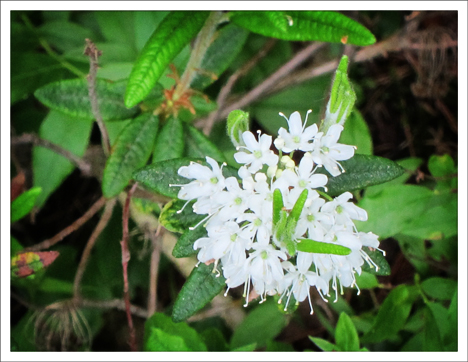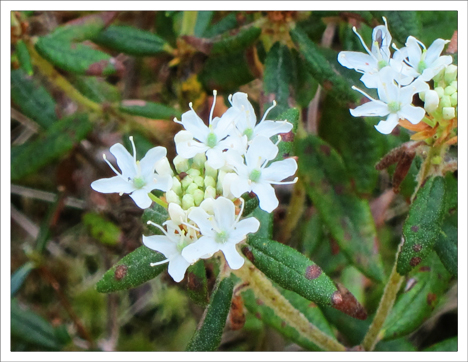Adirondack Wildflowers:
Labrador Tea (Rhododendron groenlandicum)
 Adirondack Wildflowers: Labrador Tea in bloom on Barnum Bog (30 May 2012)
Adirondack Wildflowers: Labrador Tea in bloom on Barnum Bog (30 May 2012)
| This page is no longer being updated. For an updated and expanded version of this material, see: Labrador Tea (Rhododendron groenlandicum) |
Labrador Tea is a low, evergreen shrub that grows in Adirondack wetlands. The plant has densely hairy twigs and rounded, terminal clusters of white flowers. This northern shrub, typical of acidic, boggy areas, can easily be recognized by the woolly brown undersurfaces of its leaves. It grows up to three feet tall, with smooth bark which is coppery-orange to reddish brown. The thick, glossy, narrowly elliptic leaves are aromatic. Their smooth edges turn downward, creating a raised rim around the lower surface, which is covered by a dense mat of tangled woolly hairs, which are white on young leaves and rusty on mature leaves. The leaves have been used to make tea and folk medicines, although some sources warn that all parts of the plant are highly toxic and may be fatal if eaten. In northern Canada, the plant is known as Hudson's Bay Tea.
The plant usually blooms in June, producing clusters of small (1/3" wide) white flowers with five petals. The tiny white flowers are very fragrant and sticky.
Labrador Tea grows in northern latitudes around the world. In Europe, it occurs south to the Alps, and in the United States, it reaches as far south as northern Pennsylvania, Ohio and New Jersey in the east, and Oregon in the west. In the north country, Labrador Tea grows in bogs, fens, swamps, drier acidic soil, and sometimes on rocky alpine slopes. Plants growing at higher elevations are often stunted. The plant is common in tamarack and black spruce swamps and in conifer woods throughout the region.
 Labrador Tea in bloom at the Paul Smiths VIC (26 May 2012)
Labrador Tea in bloom at the Paul Smiths VIC (26 May 2012)
Labrador Tea grows in northern latitudes around the world. In Europe, it occurs south to the Alps, and in the United States, it reaches as far south as northern Pennsylvania, Ohio and New Jersey in the east, and Oregon in the west.
In the north country, Labrador Tea grows in bogs, fens, swamps, drier acidic soil, and sometimes on rocky alpine slopes. Plants growing at higher elevations are often stunted. The plant is common in tamarack and black spruce swamps and in conifer woods throughout the region.
At the Paul Smiths VIC, Labrador Tea grows in the Barnum Bog, where it can be observed along the Boreal Life Trail boardwalk. The plant can also be seen on the edges of Heron Marsh. The plant usually begins blooming in May.
References:
- Lady Bird Johnson Wildflower Center. Native Plant Database.
- United States Department of Agriculture. Plants Database.
- Flora of North America. Plant Database.
- Doug Ladd. North Woods Wildflowers (Falcon Publishing, 2001), p. 185.
- William K. Chapman, et al. Wildflowers of New York in Color (Syracuse University Press, 1998), pp. 12-13.
- Lawrence Newcomb. Newcomb's Wildflower Guide (Little Brown and Company, 1977), pp. 292-293.
- Donald D. Cox. A Naturalist's Guide to Wetland Plants. An Ecology for Eastern North America (Syracuse University Press, 2002), pp. 90-91.
